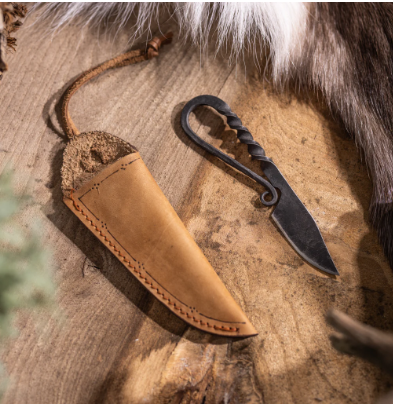In the vast expanses of Eurasia, two distinct cultures, the Yakuts of Siberia and the Vikings of Northern Europe, developed unique knife-making traditions that reflect their respective environments, lifestyles, and cultural heritage. In this article, we embark on a comparative journey to explore the similarities and differences between Yakut knives and Viking knives, shedding light on their design, craftsmanship, and cultural significance.
Yakutian Knives: Craftsmanship of the Siberian Wilderness
The Yakuts, a Turkic people inhabiting the frigid taiga of Siberia, have a long-standing tradition of knife-making dating back centuries. Their knives, known as "Yakutian knives" or "Yakut knives," are renowned for their elegance, functionality, and adaptability to the harsh conditions of the Arctic landscape.
Yakut knives typically feature a curved, single-edged blade made from high-carbon steel, meticulously forged by skilled craftsmen using traditional techniques passed down through generations. The blade's curvature allows for efficient slicing and chopping, while the sharp, durable edge ensures reliability in tasks such as hunting, skinning, and woodworking.
One distinctive feature of Yakut knife is its handle, often crafted from reindeer antler or birch bark and adorned with intricate carvings and inlays. These handles offer a secure grip even in freezing temperatures and provide a connection to the natural world that is central to Yakut culture and spirituality.
Viking Knives: Legacy of the Norse Seafarers
In the rugged lands of Scandinavia, the Vikings forged a formidable reputation as seafarers, warriors, and craftsmen. Central to their toolkit was the Viking knife, a versatile and indispensable tool that served a multitude of purposes, from everyday tasks to combat and exploration.
Viking knives were typically characterized by their straight, double-edged blades, crafted from high-quality carbon steel and featuring a robust construction optimized for cutting, slicing, and thrusting. The blades often exhibited intricate patterns and inscriptions, showcasing the skill and artistry of Norse blacksmiths.
Unlike Yakut knives, which often prioritize elegance and finesse, Viking knives are renowned for their ruggedness and utilitarian design, reflecting the practical needs of a seafaring society. The handles of Viking knives were typically made from materials such as wood, bone, or horn, providing durability and functionality in a variety of environments.
Comparative Analysis:
When comparing Yakut knives and Viking knives, several key differences and similarities emerge. While both knife-making traditions prioritize functionality and craftsmanship, they are influenced by distinct cultural, environmental, and historical factors.
Yakut knives, with their curved blades and natural materials, reflect the intimate relationship between the Yakuts and their Arctic environment, where survival hinges on resourcefulness and adaptability. In contrast, Viking knives embody the martial prowess and exploration of a seafaring culture, with their straight blades and robust construction designed for the rigors of maritime life.
Despite these differences, both Yakut and Viking knives share a common thread of craftsmanship, heritage, and utility that transcends geographical boundaries and centuries of history. Whether wielded by Yakut hunters on the frozen tundra or Viking warriors on the open seas, these blades remain enduring symbols of human ingenuity and resilience in the face of adversity.

